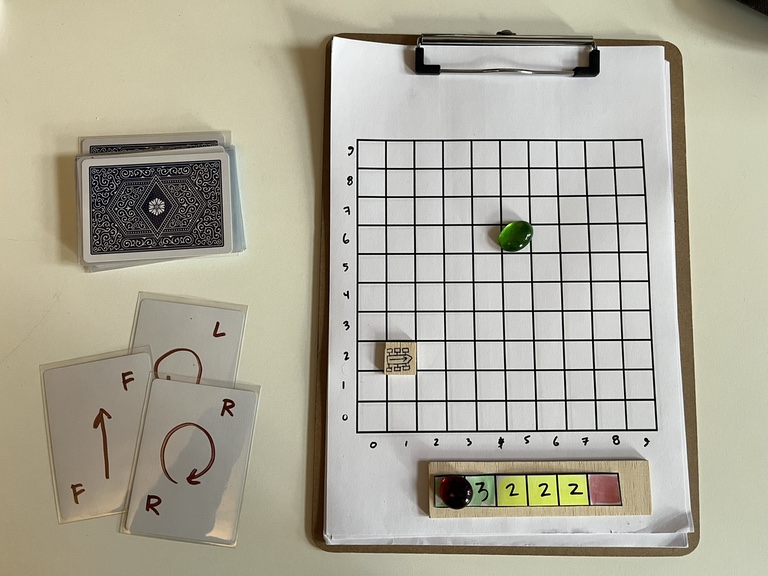Planetary Rover
Overview
Co-op game for 2-4 players, around 40 minutes

Planetary Rover is a game for 2-4 players, where players try to cooperatively pilot an exploratory rover on the surface of a remote planet. Players play cards from their hands to create and execute programs for the rover's movement. Using these programs, players try to accomplish increasingly complex scenario goals before their rover runs out of resources.
Setup
Each scenario has a mission plan with important information to set up the mission. This includes:
- The mission map, which indicates the insertion coordinates (starting position) for the rover and the location and value of the mission goals.
- A resource bar which indicates the number of days allotted for the mission and the number of instructions (the player hand size in cards) that players have each day.
- The number of points that the players receive for completing the scenario goals.
- The conditions under which the scenario is successful.
The rover is placed on the map on the indicated starting position, and the resource marker is placed on the first position of the scenario resource bar. Players are each dealt the number of cards indicated for the first resource bar position.
Remaining cards are placed in the stockpile.
Players leave space for two areas on the playfield. The "shared memory" sits directly next to the map. And the "stack" is played on the map near the stockpile.
Play
Players may discuss who would like to go first, and then play proceeds clockwise from the first player.
On each player's turn, they must take one of the following actions actions:
- Play a card from their hand to the top of the instruction stack. These instructions are stacked until a player executes the stack. Player's should immediately replace the card from their hand with one from the stockpile at the end of their turn.
- Play a card from their hand to the shared memory area. The shared memory area can hold up to four cards at any time. If the shared memory area is full, a player must first discard a card from it before adding a new one. Players should immediately replace the card from their hand with one from the stockpile at the end of their turn.
- Play a card from the shared memory to the top of the stack. This opens up a slot of shared memory. The player does not draw.
- Execute all instructions on the stack. When a player executes the program (all instructions which are currently in the stack), the rover takes each action in sequence, starting with the top instruction–or last card played–followed by the card directly beneath it until the entire stack has been played.
As cards are executed, they are moved from the instruction stack into the discard pile until the stack is empty. When the stockpile is depleted, shuffle the discard pile into the stockpile. If both the stockpile and the discard pile are empty, players skip their draw phase.
Each time the instruction stack is executed, the gameplay is advanced in two important ways:
- The rover moves on the map, action by action. The position is check for goals at each step. A rover accomplishes a goal if the rover reaches it at any step (for now at least).
- After the movement is completed, the marker on the resource bar advances one step. This may lead to a different hand size for the next round. If the marker would advance past the end of the bar, the game is over.
- If one of the scenario's target coordinates was reached while the instruction stack was executed, the resource marker does not advance.
Shared Memory
The shared memory area is a cooperative planning zone visible to all players. This area allows for limited strategic coordination between players. The shared memory functions as follows:
- On their turn, players may play a card from their hand to the shared memory instead of directly to the instruction stack.
- On their turn, players may play a card from the shared memory to the instruction stack instead of playing from their hand. When doing so, they do not draw a replacement card.
- The shared memory area is visible to all players, creating an opportunity for strategic planning despite the "no table talk" rule.
No table talk!
Players are not allowed to discuss what instructions are in their hands. However, the shared memory area provides a way for players to communicate their intentions without explicit discussion.
Ending the game
The game is over when the players either:
- Accumulate 10 points from successfully completed scenarios
- Advance the marker past the end of the resource bar in any scenario
Cards in the deck
Players will (currently) find the following available instructions:
- Forward move the rover forward (based on facing) one square
- Backward move the rover backward one square
- Turn right rotate the rover 90 degrees to the right
- Turn left rotate the rover 90 degrees to the left
- No-op do nothing
- Copy treat this instruction as a copy of the instruction directly beneath it (next instruction on the stack)
- Clear mem discard all cards from the stack without executing. The stack is empty but play continues. The resource marker is not advanced.
Extending the mission
If the players have met the scenario goals, they can choose to extend the mission, rather than ending the scenario. If the players extend the mission they cannot choose to end the scenario again until the rover has reached another target site. Basically, this gives players the option to "press their luck" in order to acquire more points.

